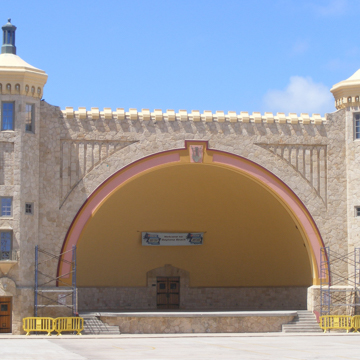Considered by many to have been the most important Florida project of the Works Progress Administration, the late Gothic Revival Daytona Beach Bandshell was hailed as the largest structure of its type in the world when it opened. Holding 4,200 people in its amphitheater, the bandshell was part of a complex of New Deal buildings along the oceanfront in Daytona Beach that were built to point to a new future for the region and for Florida as a whole. As Roosevelt’s administration sought solutions to regional problems, the issue of Florida’s seasonal tourism, and thus the seasonal economy, was of primary concern. Of all cities in Florida, Daytona Beach, with its average winter weather of 69 degrees and average summer weather of 79 degrees, along with its world-famous on-beach automobile races, had achieved the greatest success balancing summer and winter tourism. Tens of thousands of tourists from Georgia, Alabama, Mississippi, Tennessee, and the Carolinas arrived in the city each summer. The bandshell, amphitheater, and the accompanying shops and other amenities were intended to provide year-round infrastructure to support and grow this tourism.
Pennsylvania native Alan J. MacDonough had been working in Florida since 1910, establishing a successful practice in the region that included monumental public and large private commissions. In 1934, MacDonough moved to Daytona Beach, where he became the head of the Federal Emergency Relief Administration, the forerunner to the Works Progress Administration. MacDonough had the experience with large-scale buildings that served him well in designing the bandshell and amphitheater. During this time he developed an interest in coquina, a durable native sedimentary stone made entirely from tiny shells that had been used most famously by the Spanish as the structural stone in the Castillo de San Marco in St. Augustine.
As the focal point of the New Deal efforts in Daytona Beach, the steel-reinforced concrete bandshell measures 48 by 114 feet, boasting a 52-foot-wide stage. The bandshell is anchored by two crenellated towers that feature lanterns on top, windows, window blanks, and balconies. Running across the top of the stage between the towers is a crenellated roof structure. The keystone in the arching roof over the stage supports a lyre and in the spandrels of the arches are what appear to be abstracted organ pipes. Flying buttresses with delicately curved and straight elements support crenellated tops that reinforce the building at each corner of the building and form the backside of the bandshell.
After a series of financial difficulties and setbacks, the bandshell officially opened on January 1, 1938. It soon became the top tourist destination in the city, providing space for concerts, religious services, and other types of entertainment. Although damaged in hurricanes of 1947 and 1967, the bandshell remains to this day a monument to the intentions of the New Deal in Florida—a confection of fantastic imagery, public space, and local materials.
References
Cardwell, Harold D., and Priscilla D. Cardwell. Historic Daytona Beach.Charleston, S.C.: Arcadia Pub., 2004.
“Daytona Beach Called Marvel of Smoothness.” Christian Science Monitor, December 13, 1941.
“Daytona Beach Harmonizes.” Christian Science Monitor, December 11, 1937.
“Daytona Exploited as Summer Resort.” Miami Herald, June 18, 1937.
“Near Million Spent at Daytona Beach.” Chicago Tribune, December 12, 1937.
Olausen, Steve, and Gary V. Goodwin, “Daytona Beach Bandshell,” Volusia County, Florida. National Register of Historic Places Registration Form, 1998. National Park Service, U.S. Department of the Interior, Washington, D.C.














